Circularly Polarized Antenna Array with Decoupled Quad Vortex Beams
Abstract
:1. Introduction
2. Theoretical Background
3. Dual-LP Element Design
4. Design of Quad-Vortex-Beam Planar Array
5. Results and Discussion
6. Conclusions
Author Contributions
Funding
Institutional Review Board Statement
Informed Consent Statement
Data Availability Statement
Acknowledgments
Conflicts of Interest
References
- Willner, A.E.; Huang, H.; Yan, Y.; Ren, Y.; Ahmed, N.; Xie, G.; Bao, C.; Li, L.; Cao, Y.; Zhao, Z.; et al. Optical communications using orbital angular momentum beams. Adv. Opt. Phot. 2015, 7, 66–106. [Google Scholar] [CrossRef]
- Thide, B.; Then, H.; Sjoholm, J.; Palmer, K.; Bergman, J.; Carozzi, T.D.; Istomin, Y.N.; Ibragimov, N.H.; Khamitova, R. Utilization of photon orbital angular momentum in the low-frequency radio domain. Phys. Rev. Lett. 2007, 99, 087701. [Google Scholar] [CrossRef]
- Heckenberg, N.R.; McDuff, R.; Smith, C.P.; White, A.G. Generation of optical phase singularities by computer-generated holograms. Opt. Lett. 1992, 17, 221–223. [Google Scholar] [CrossRef]
- Chen, H.; Hao, J.; Zhang, B.-F.; Xu, J.; Ding, J.; Wang, H.-T. Generation of vector beam with space-variant distribution of both polarization and phase. Opt. Lett. 2011, 36, 3179–3181. [Google Scholar] [CrossRef]
- Yang, Y.; Wang, W.; Moitra, P.; Kravchenko, I.I.; Briggs, D.P.; Valentine, J. Dielectric meta-reflectarray for broadband linear polarization conversion and optical vortex generation. Nano Lett. 2014, 14, 1394–1399. [Google Scholar] [CrossRef]
- Chen, S.; Liu, W.; Li, Z.; Cheng, H.; Tian, J. Metasurface-empowered optical multiplexing and multifunction. Adv. Mater. 2020, 32, e1805912. [Google Scholar] [CrossRef]
- Hu, P.F.; Pan, Y.M.; Leung, K.W.; Zhang, X.Y. Wide-/dual-band omnidirectional filtering dielectric resonator antennas. IEEE Trans. Antennas Propag. 2018, 66, 2622–2627. [Google Scholar] [CrossRef]
- Wang, J.X.; Cheng, Y.Z.; Luo, H.; Chen, F.; Wu, L. High-gain bidirectional radiative circularly polarized antenna based on focusing metasurface. Int. J. Electron. Commun. 2022, 151, 154222. [Google Scholar] [CrossRef]
- Tang, H.; Tong, C.; Chen, J.-X. Multifunction applications of substrate integrated waveguide cavity in dielectric resonator antennas and reconfigurable circuits. IEEE Trans. Antennas Propag. 2019, 67, 5700–5704. [Google Scholar] [CrossRef]
- Guo, W.L.; Wang, G.M.; Luo, X.Y.; Hou, H.S.; Chen, K.; Feng, Y. Ultrawideband spin-decoupled coding metasurface for independent dual-channel wavefront tailoring. Ann. Phy. 2020, 532, 1900472. [Google Scholar] [CrossRef]
- Li, W.; Zhu, J.; Liu, Y.; Zhang, B.; Liu, Y.; Liu, Q.H. Realization of third-order OAM mode using ring patch antenna. IEEE Trans. Antennas Propag. 2020, 68, 7607–7611. [Google Scholar] [CrossRef]
- Guo, C.; Zhao, X.W.; Zhu, C.; Xu, P.; Zhang, Y. An OAM patch antenna design and its array for higher order OAM mode generation. IEEE Antennas Wirel. Propag. Lett. 2019, 18, 816–820. [Google Scholar] [CrossRef]
- Manteuffel, D.; Lin, F.H.; Li, T.; Peitzmeier, N.; Chen, Z.N. Characteristic mode inspired advanced multiple antennas: Intuitive insight into element-, interelement-, and array levels of compact large arrays and metantennas. IEEE Antennas Propag. Mag. 2022, 64, 49–57. [Google Scholar] [CrossRef]
- Lau, B.K.; Capek, M.; Hassan, A.M. Characteristic modes: Progress, overview, and emerging topics. IEEE Antennas Propag. 2022, 64, 14–22. [Google Scholar] [CrossRef]
- Shen, F.; Mu, J.; Guo, K.; Guo, Z. Generating circularly polarized vortex electromagnetic waves by the conical conformal patch antenna. IEEE Trans. Antennas Propag. 2019, 67, 5763–5771. [Google Scholar] [CrossRef]
- Liang, J.; Jing, Z.; Feng, Q.; Zheng, Y.; Li, L. Synthesis and measurement of a circular-polarized deflection OAM vortex beam with sidelobe suppression array. IEEE Access 2020, 8, 89143–89151. [Google Scholar] [CrossRef]
- Lin, M.; Gao, Y.; Liu, P.; Guo, Z. Performance analyses of the radio orbital angular momentum steering technique based on ka-band antenna. Int. J. Antennas Propag. 2017, 2017, 8050652. [Google Scholar] [CrossRef]
- Bi, K.; Xu, J.; Yang, D.; Hao, Y.; Gao, X.; Huang, S. Generation of Orbital Angular Momentum Beam With Circular Polarization Ceramic Antenna Array. IEEE Photonics J. 2019, 11, 7901508. [Google Scholar] [CrossRef]
- Assimonis, S.D.; Abbasi, M.A.B.; Fusco, V. Millimeter-wave multi-mode circular antenna array for uni-cast multi-cast and OAM communication. Sci. Rep. 2021, 11, 4928. [Google Scholar] [CrossRef]
- Xu, J.; Guo, Y.; Yang, P.; Zhang, R.; Zhai, X.; Huang, S.; Bi, K. Recent progress on RF orbital angular momentum antennas. J Electromagn. Wave 2020, 34, 275–300. [Google Scholar] [CrossRef]
- Zheng, S.; Hui, X.; Jin, X.; Chi, H.; Zhang, X. Transmission characteristics of a twisted radio wave based on circular traveling-wave antenna. IEEE Trans. Antennas Propag. 2015, 63, 1530–1536. [Google Scholar] [CrossRef]
- Liang, J.; Zhang, S. Orbital Angular Momentum (OAM) generation by cylinder dielectric resonator antenna for future wireless communications. IEEE Access 2016, 4, 9570–9574. [Google Scholar] [CrossRef]
- Hui, X.; Zheng, S.; Chen, Y.; Hu, Y.; Jin, X.; Chi, H.; Zhang, X. Multiplexed millimeter wave communication with dual orbital angular momentum (OAM) mode antennas. Sci. Rep. 2015, 5, 10148. [Google Scholar] [CrossRef]
- Comite, D.; Valerio, G.; Albani, M.; Galli, A.; Casaletti, M.; Ettorre, M. Exciting vorticity through higher order Bessel beams with a radialline slot-array antenna. IEEE Trans. Antennas Propag. 2017, 65, 2123–2128. [Google Scholar] [CrossRef]
- Chen, M.L.; Jiang, L.J.; Sha, W.E.I. Ultrathin complementary metasurface for orbital angular momentum generation at microwave frequencies. IEEE Trans. Antennas Propag. 2017, 65, 396–400. [Google Scholar] [CrossRef]
- Lv, H.H.; Huang, Q.L.; Yi, X.J.; Hou, J.Q.; Shi, X.W. Low-profile transmitting metasurface using single dielectric substrate for OAM generation. IEEE Antennas Wirel. Propag. Lett. 2020, 19, 881–885. [Google Scholar] [CrossRef]
- Xu, H.; Hu, G.; Jiang, M.; Tang, S.; Wang, Y.; Wang, C.; Huang, Y.; Ling, X.; Liu, H.; Zhou, J. Wavevector and frequency multiplexing performed by a spin-decoupled multichannel metasurface. Adv. Mater. Technol. 2020, 5, 1900710. [Google Scholar] [CrossRef]
- Yu, S.; Li, L.; Shi, G.; Zhu, C.; Shi, Y. Generating multiple orbital angular momentum vortex beams using a metasurface in radio frequency domain. Appl. Phy. Lett. 2016, 108, 662. [Google Scholar] [CrossRef]
- Zhou, E.Y.; Cheng, Y.Z.; Chen, F.; Luo, H. Wideband and high-gain patch antenna with reflective focusing metasurface. Int. J. Electron. Commun. 2021, 134, 153709. [Google Scholar] [CrossRef]
- Xu, H.-X.; Liu, H.; Ling, X.; Sun, Y.; Yuan, F. Broadband vortex beam generation using multimode Pancharatnam–Berry metasurface. IEEE Trans. Antennas Propag. 2017, 65, 7378–7382. [Google Scholar] [CrossRef]
- Liu, D.; Gui, L.; Chen, K.; Lang, L.; Zhang, Z.; Chen, H.; Liu, L.; Jiang, T. Theoretical analysis and comparison of OAM waves generated by three kinds of antenna array. Digit. Commun. Netw. 2021, 7, 16–28. [Google Scholar] [CrossRef]
- Mohammadi, S.M.; Daldorff, L.K.; Bergman, J.E.; Karlsson, R.L.; Thidé, B.; Forozesh, K.; Carozzi, T.D.; Isham, B. Orbital angular momentum in radio—A system study. IEEE Trans. Antennas Propag. 2010, 58, 565–572. [Google Scholar] [CrossRef]
- Luo, Q.; Gao, S.; Sobhy, M.; Sumantyo, J.T.S.; Li, J.; Wei, G.; Xu, J.; Wu, C. Dual circularly polarized equilateral triangular patch array. IEEE Trans. Antennas Propag 2016, 64, 2255–2262. [Google Scholar] [CrossRef]
- Zhang, T.; Hu, J.; Zhang, Q.; Zhu, D.; Ma, Y.; Lin, B.; Wu, W. A compact multimode OAM antenna using sequentially rotated configuration. IEEE Antennas Wirel. Propag. Lett. 2022, 21, 134–138. [Google Scholar] [CrossRef]
- Zhang, Y.-M.; Li, J.-L. Comments on radial uniform circular antenna array for dual-mode OAM communication. IEEE Antennas Wirel. Propag. Lett. 2018, 17, 719–721. [Google Scholar] [CrossRef]
- Ma, R.F.; Jiang, Z.H.; Zhang, Y.; Wu, X.Y.; Yue, T.; Hong, W.; Werner, D.H. Theory, design, and verification of dual-circularly polarized dual-beam arrays with independent control of polarization: A generalization of sequential rotation arrays. IEEE Trans. Antennas Propag. 2021, 69, 1369–1382. [Google Scholar] [CrossRef]
- Liu, S.; Cui, T.J.; Zhang, L.; Xu, Q.; Wang, Q.; Wan, X.; Gu, J.Q.; Tang, W.X.; Qi, M.Q.; Han, J.G.; et al. Convolution operations on coding metasurface to reach flexible and continuous controls of terahertz beams. Adv. Sci. 2016, 3, 1600156. [Google Scholar] [CrossRef]
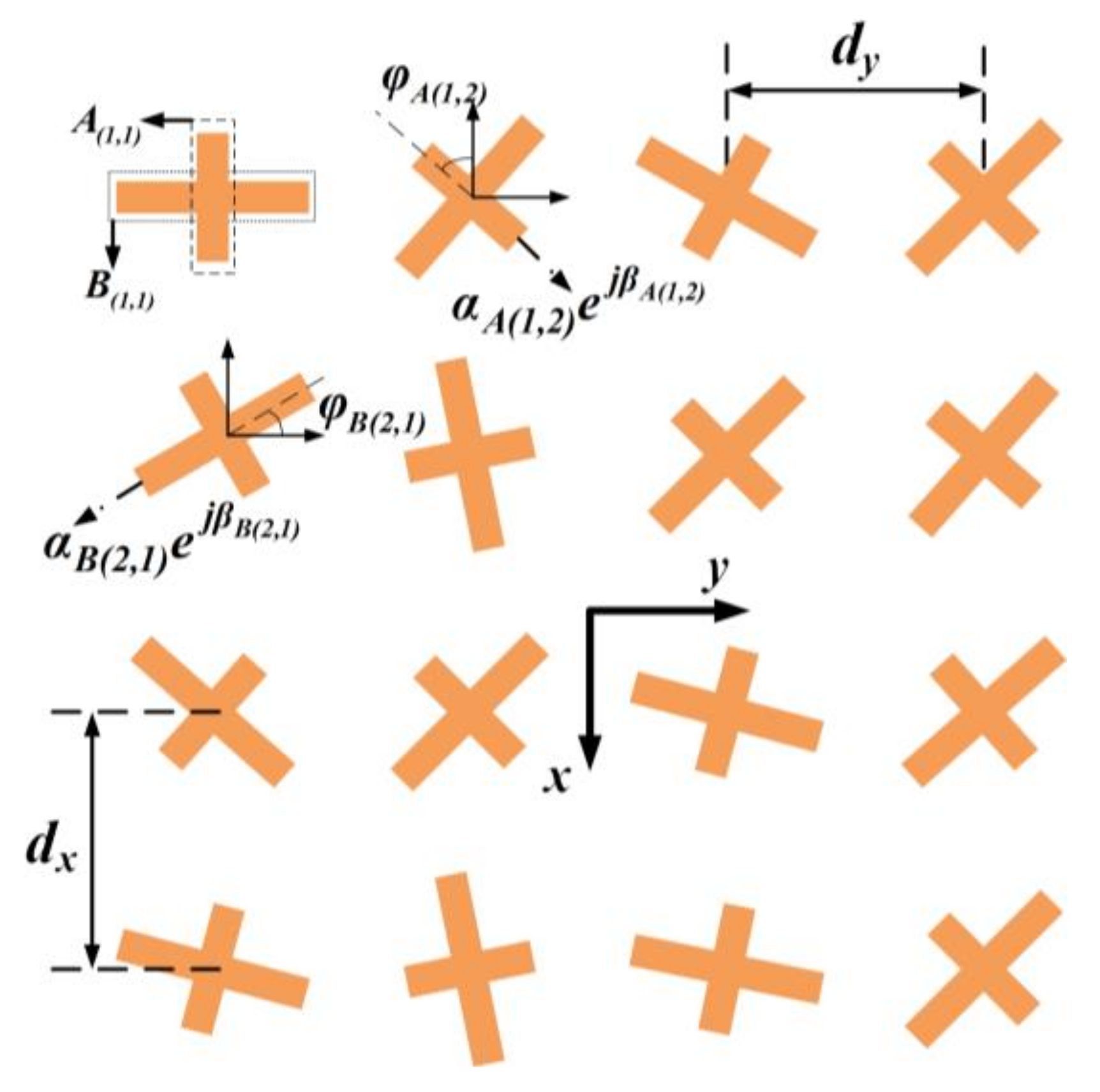
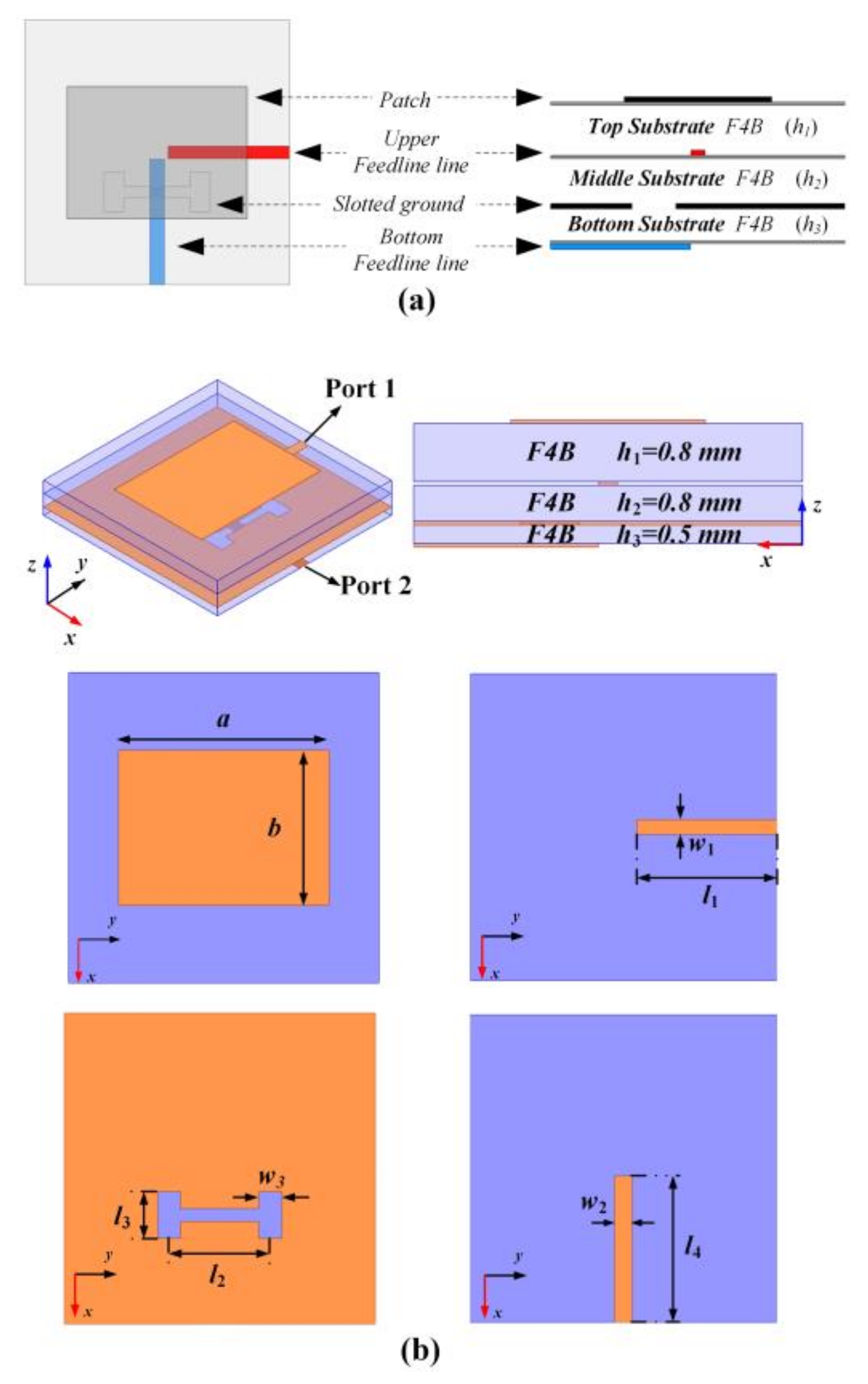
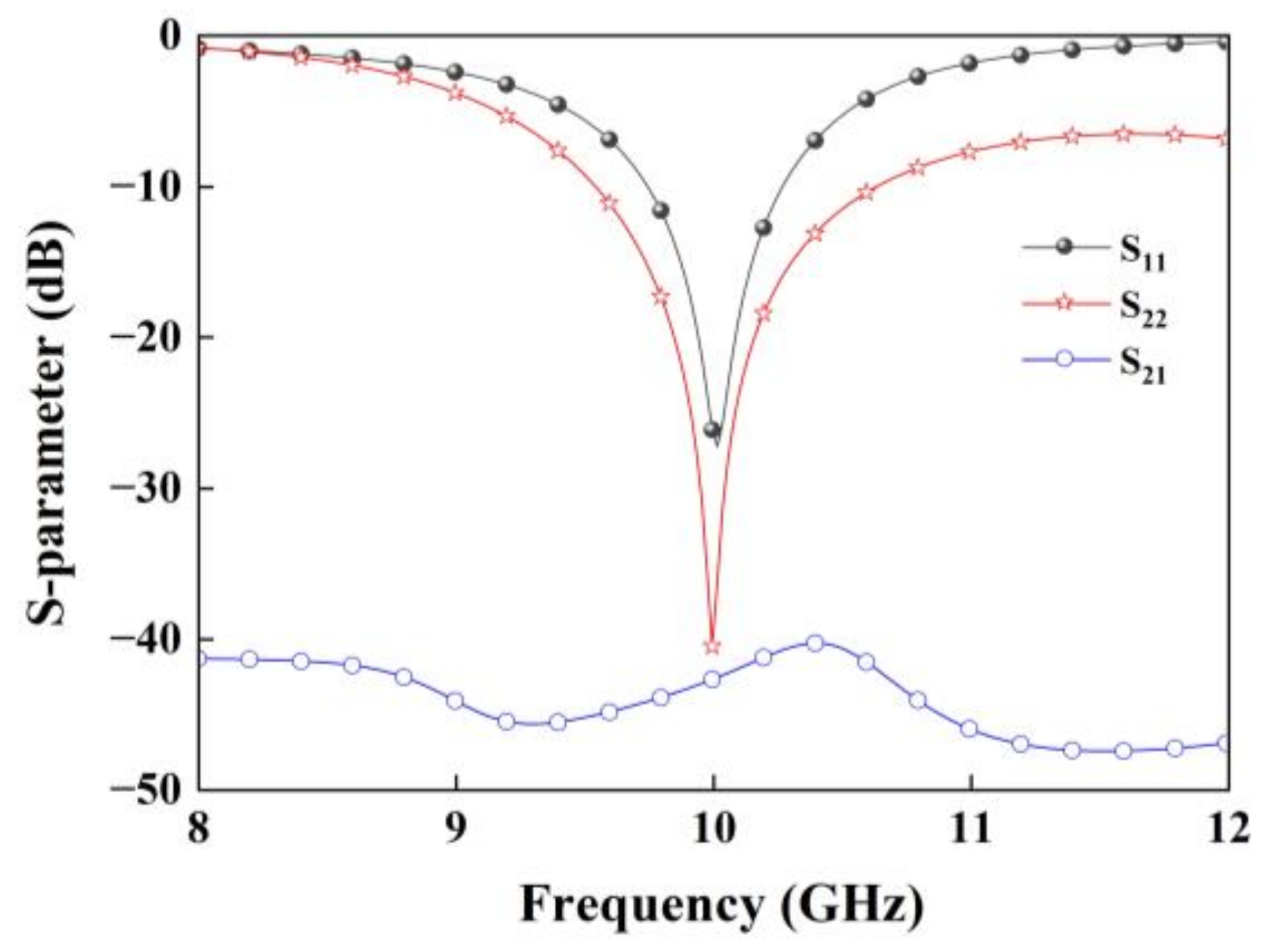
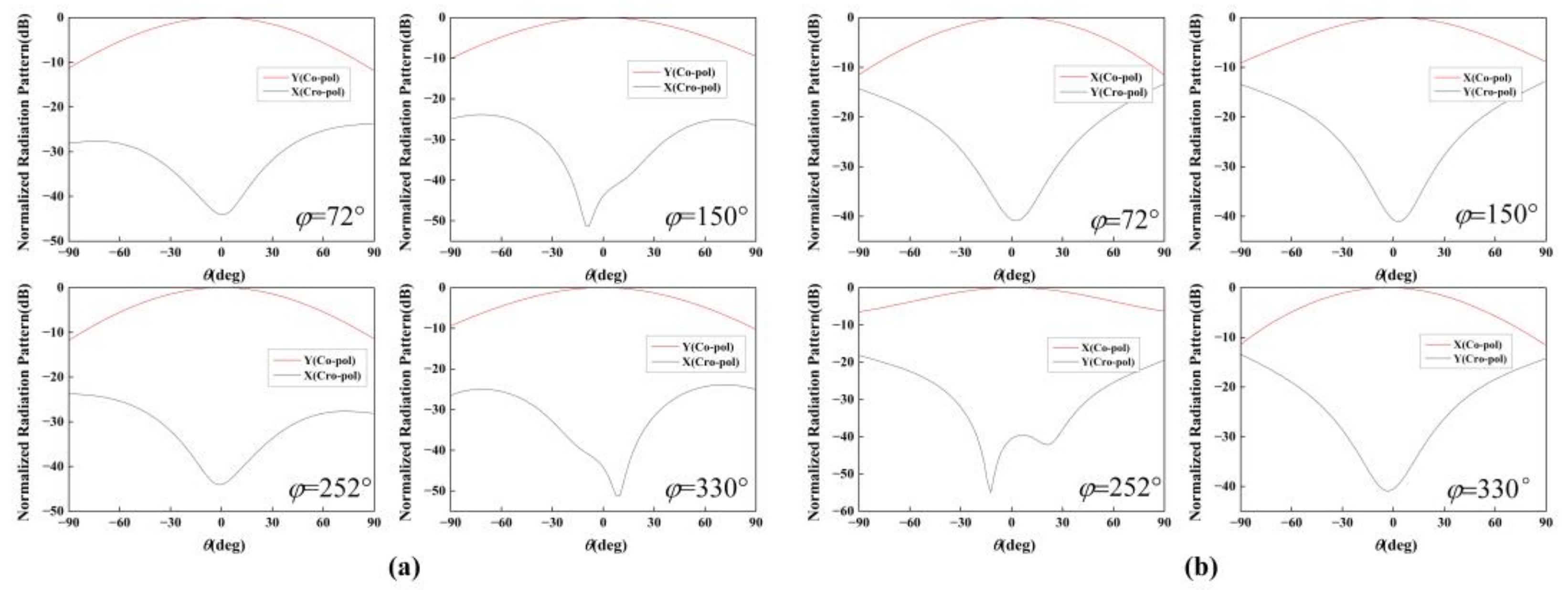
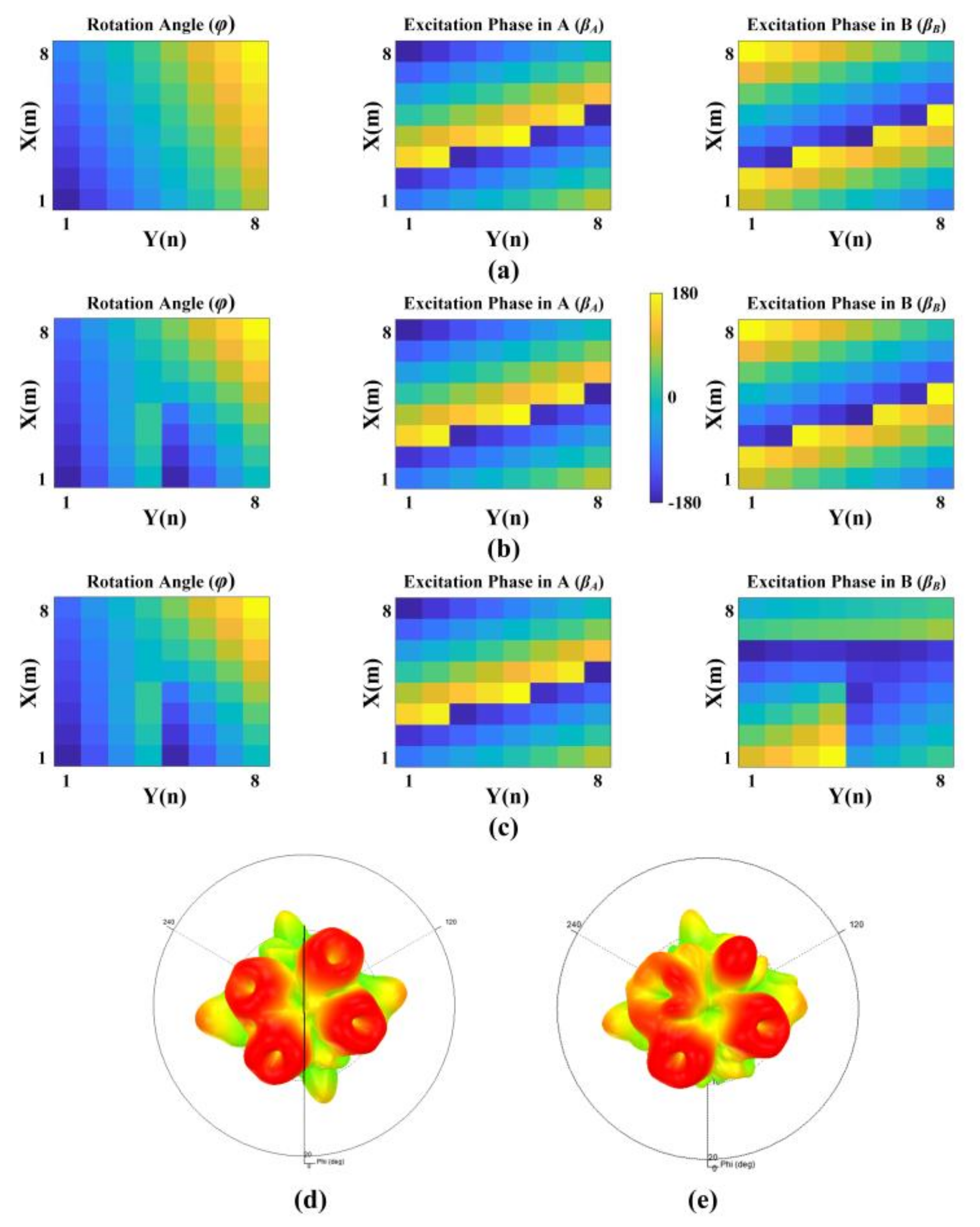
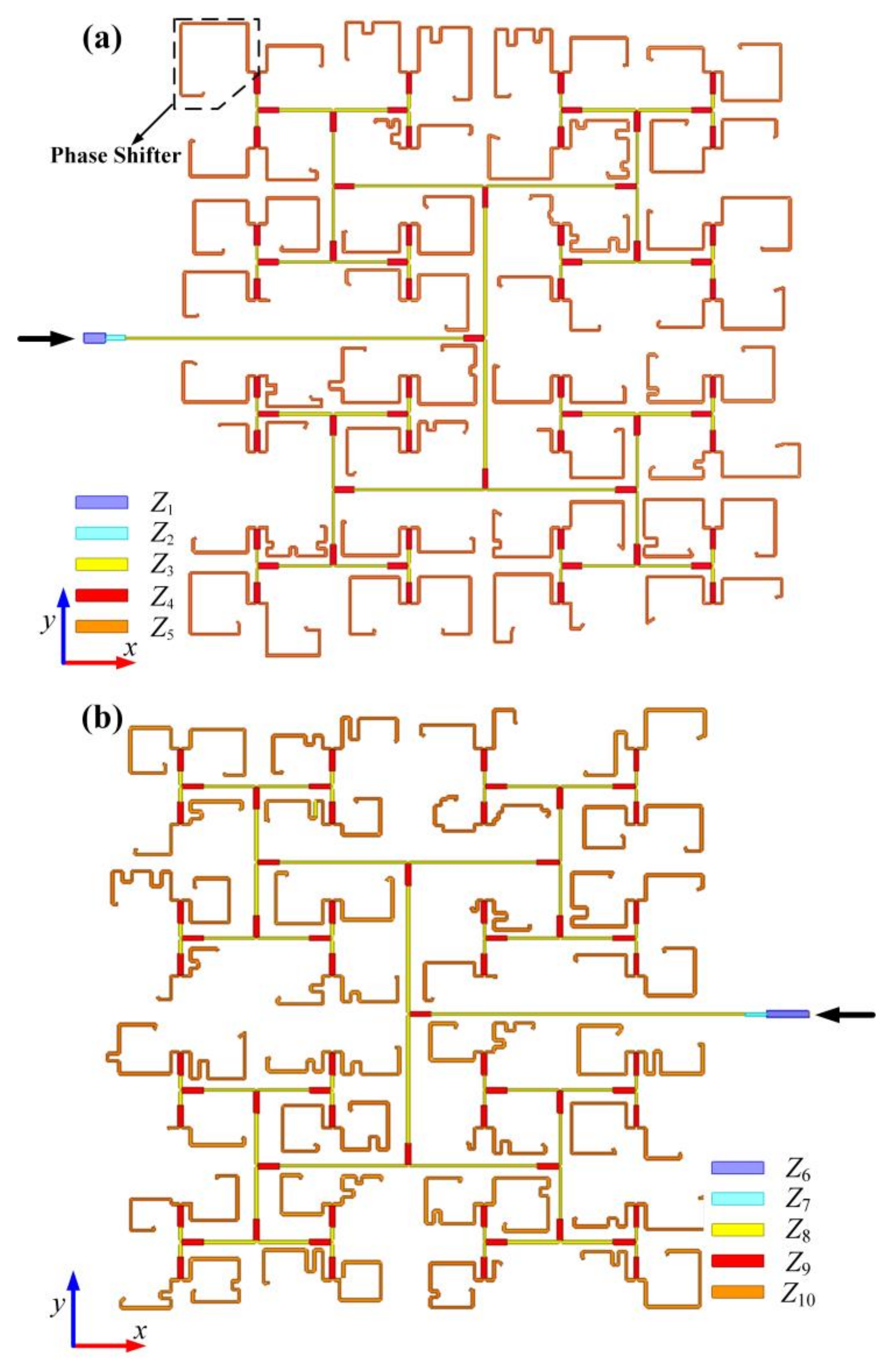
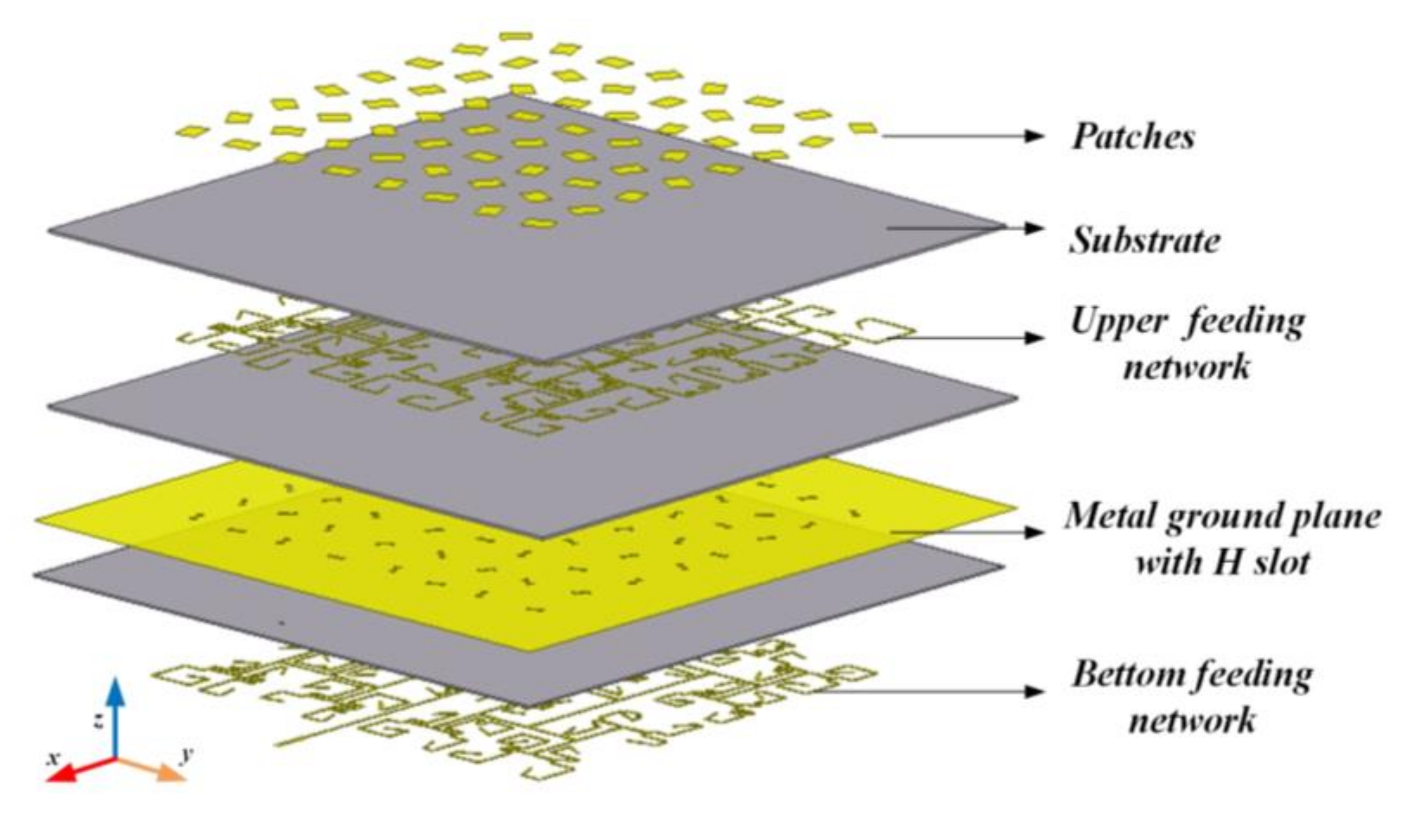
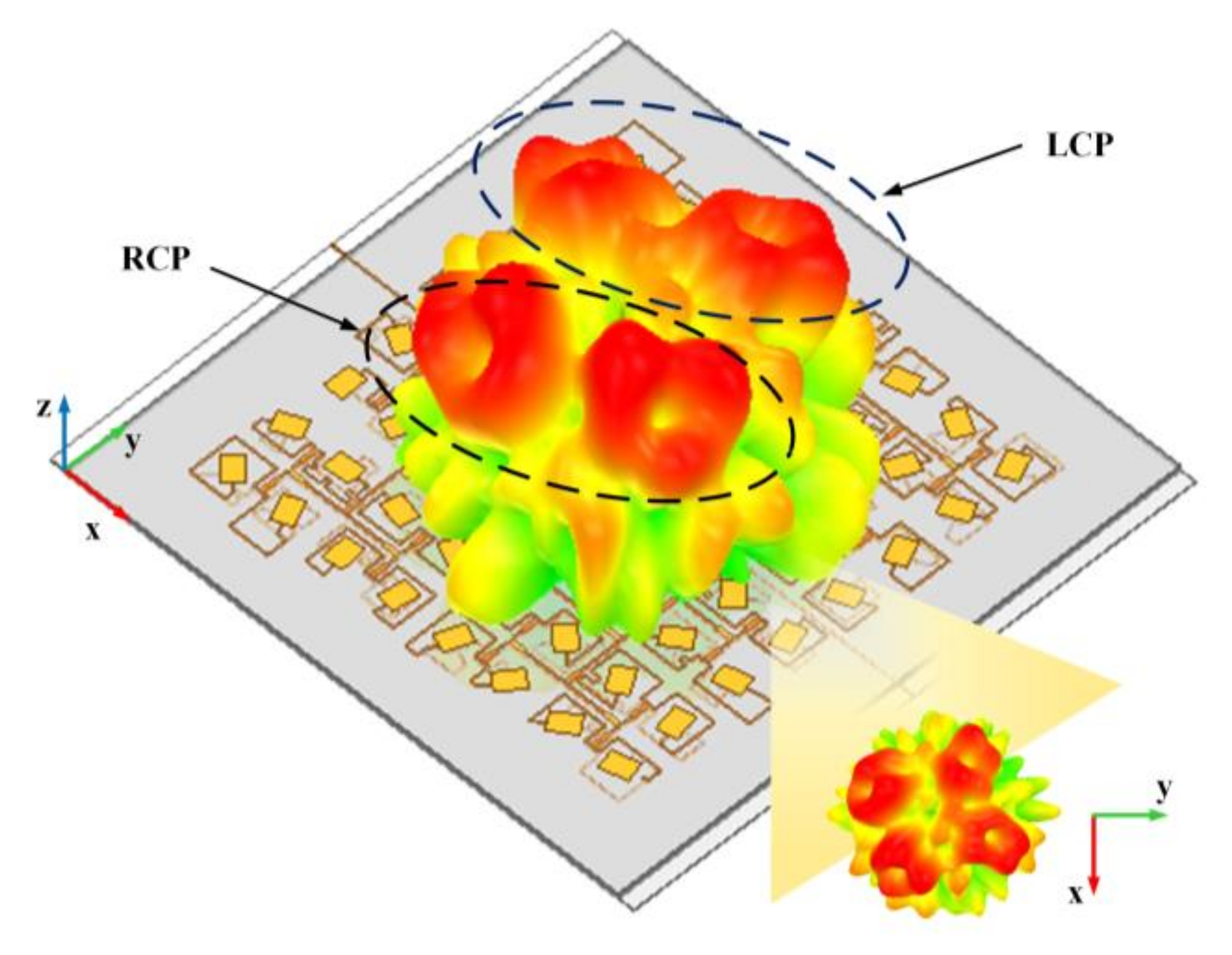



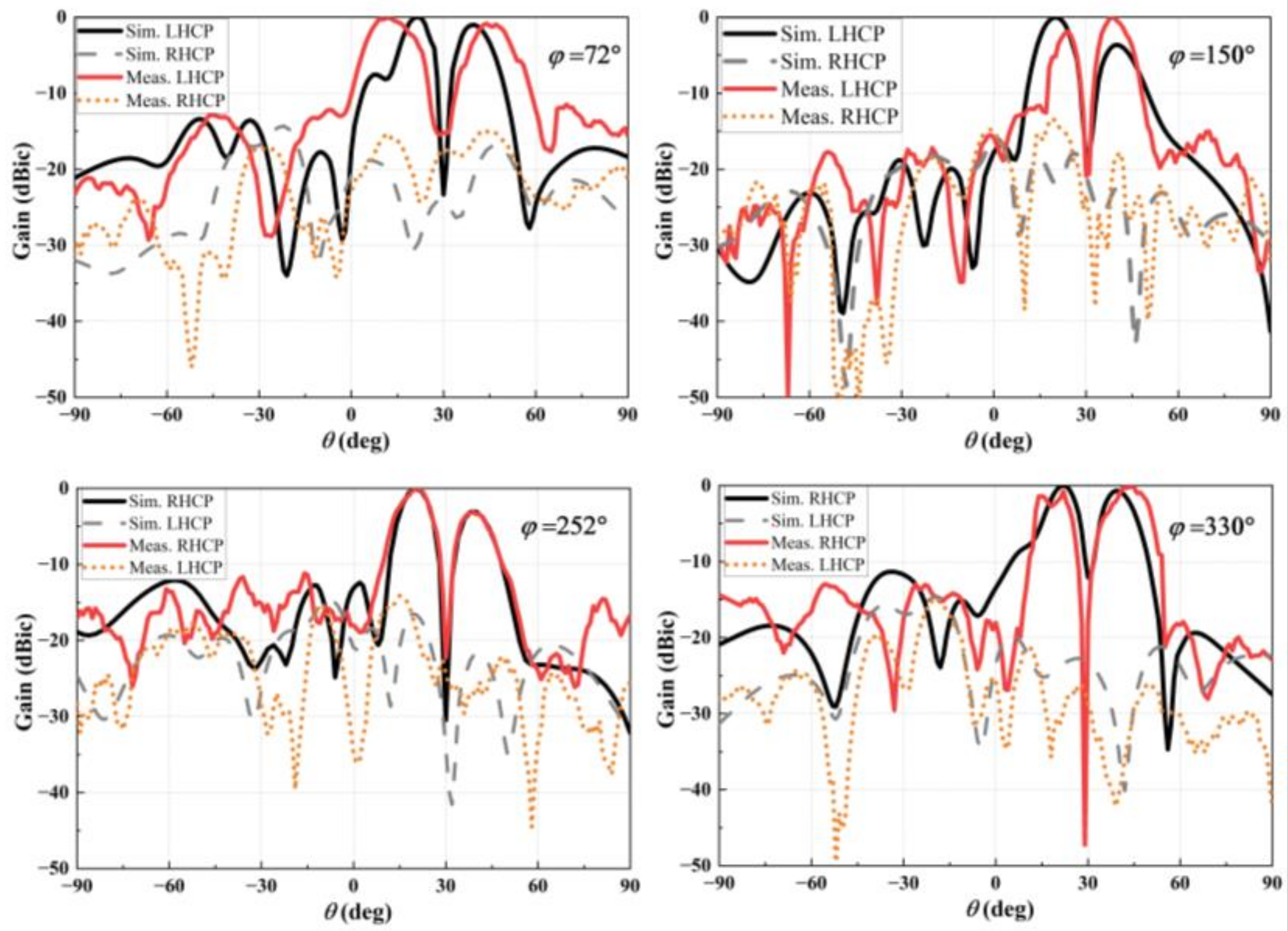
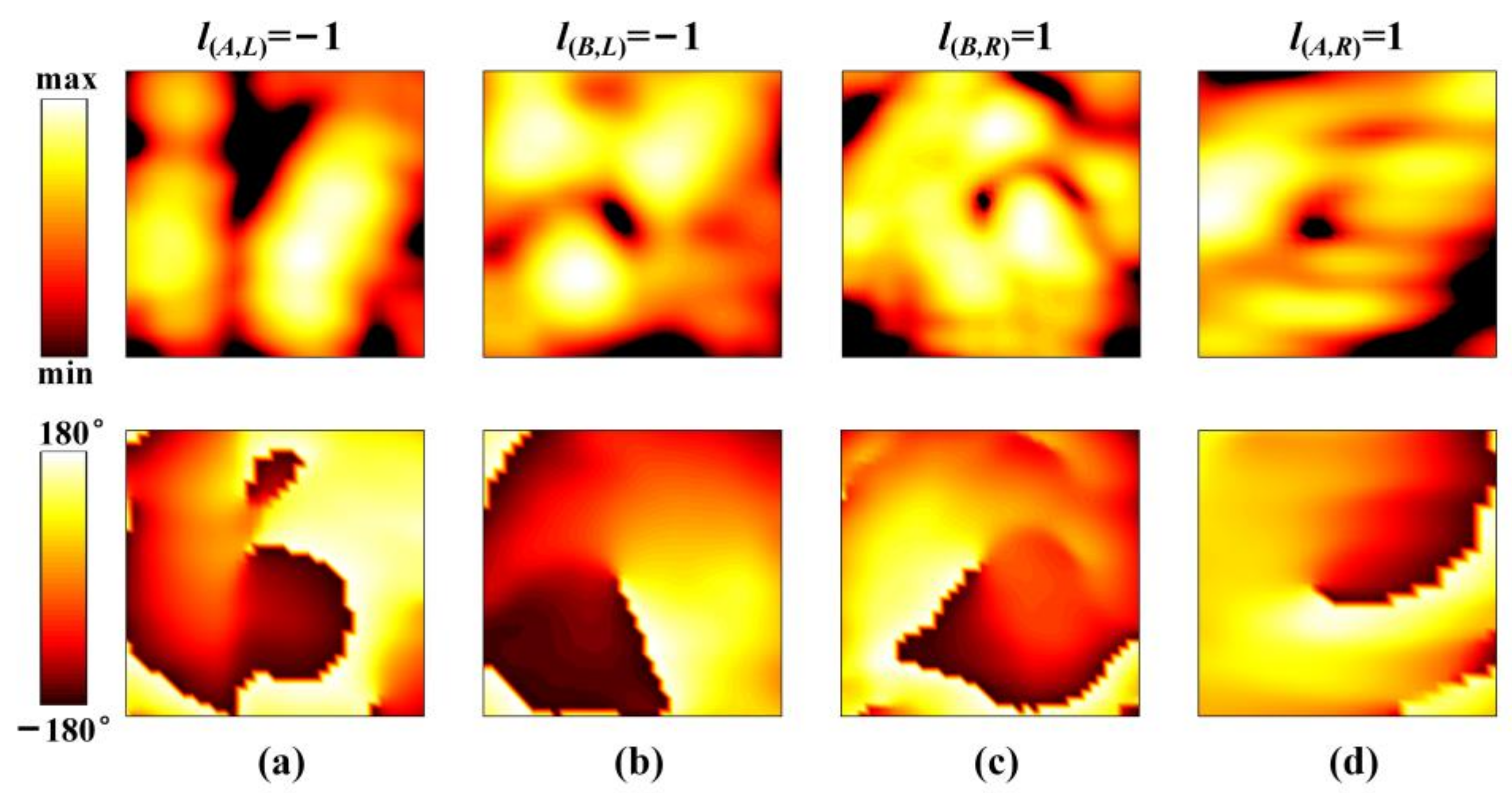
| l(A,L) | l(A,R) | l(B,L) | l(B,R) | |
|---|---|---|---|---|
| l1ϕ in φ | −l1 | l1 | −l1 | l1 |
| l2ϕ in βA | l2 | l2 | / | / |
| l3ϕ in βB | / | / | l3 | l3 |
| Final topological charge | −l1 + l2 | l1 + l2 | l1 + l3 | l1 + l3 |
| Z1 | Z2 | Z3 | Z4 | Z5 | |
|---|---|---|---|---|---|
| Z (Ω) | 50 | 67 | 92 | 65 | 92 |
| Width (mm) | 2.25 | 1.25 | 0.56 | 1.3 | 0.56 |
| Length (mm) | 5 | 4.7 | 3.97~80.27 | 4.75 | / |
| Z6 | Z7 | Z8 | Z9 | Z10 | |
|---|---|---|---|---|---|
| Z (Ω) | 50 | 61 | 75 | 53 | 75 |
| Width (mm) | 1.43 | 0.86 | 0.67 | 1.23 | 0.67 |
| Length (mm) | 10 | 5.08 | 3.6~74.5 | 5.06 | / |
Publisher’s Note: MDPI stays neutral with regard to jurisdictional claims in published maps and institutional affiliations. |
© 2022 by the authors. Licensee MDPI, Basel, Switzerland. This article is an open access article distributed under the terms and conditions of the Creative Commons Attribution (CC BY) license (https://creativecommons.org/licenses/by/4.0/).
Share and Cite
Xu, S.; Xu, H.-X.; Wang, Y.; Xu, J.; Wang, C.; Pang, Z.; Luo, H. Circularly Polarized Antenna Array with Decoupled Quad Vortex Beams. Nanomaterials 2022, 12, 3083. https://doi.org/10.3390/nano12173083
Xu S, Xu H-X, Wang Y, Xu J, Wang C, Pang Z, Luo H. Circularly Polarized Antenna Array with Decoupled Quad Vortex Beams. Nanomaterials. 2022; 12(17):3083. https://doi.org/10.3390/nano12173083
Chicago/Turabian StyleXu, Shuo, He-Xiu Xu, Yanzhao Wang, Jian Xu, Chaohui Wang, Zhichao Pang, and Huiling Luo. 2022. "Circularly Polarized Antenna Array with Decoupled Quad Vortex Beams" Nanomaterials 12, no. 17: 3083. https://doi.org/10.3390/nano12173083
APA StyleXu, S., Xu, H.-X., Wang, Y., Xu, J., Wang, C., Pang, Z., & Luo, H. (2022). Circularly Polarized Antenna Array with Decoupled Quad Vortex Beams. Nanomaterials, 12(17), 3083. https://doi.org/10.3390/nano12173083






